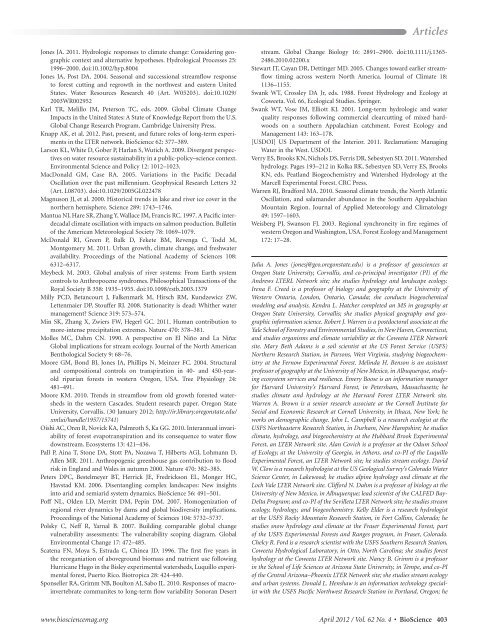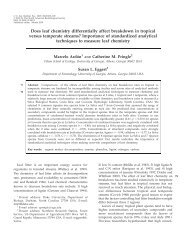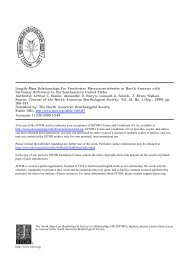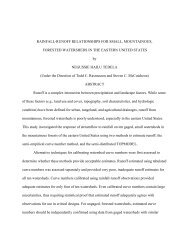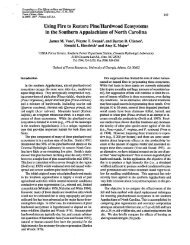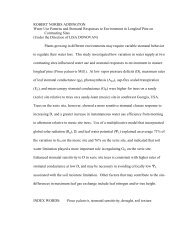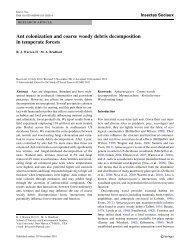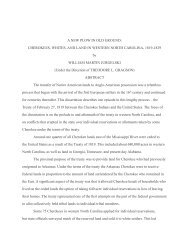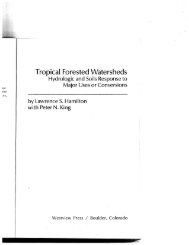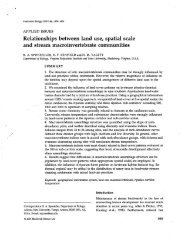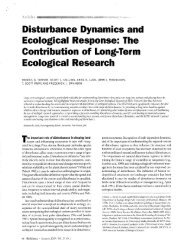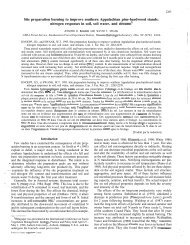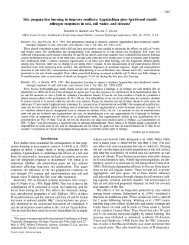biology join - Coweeta LTER - University of Georgia
biology join - Coweeta LTER - University of Georgia
biology join - Coweeta LTER - University of Georgia
Create successful ePaper yourself
Turn your PDF publications into a flip-book with our unique Google optimized e-Paper software.
Jones JA. 2011. Hydrologic responses to climate change: Considering geographic<br />
context and alternative hypotheses. Hydrological Processes 25:<br />
1996–2000. doi:10.1002/hyp.8004<br />
Jones JA, Post DA. 2004. Seasonal and successional streamflow response<br />
to forest cutting and regrowth in the northwest and eastern United<br />
States. Water Resources Research 40 (Art. W05203). doi:10.1029/<br />
2003WR002952<br />
Karl TR, Melillo JM, Peterson TC, eds. 2009. Global Climate Change<br />
Impacts in the United States: A State <strong>of</strong> Knowledge Report from the U.S.<br />
Global Change Research Program. Cambridge <strong>University</strong> Press.<br />
Knapp AK, et al. 2012. Past, present, and future roles <strong>of</strong> long-term experiments<br />
in the <strong>LTER</strong> network. BioScience 62: 377–389.<br />
Larson KL, White D, Gober P, Harlan S, Wutich A. 2009. Divergent perspectives<br />
on water resource sustainability in a public-policy–science context.<br />
Environmental Science and Policy 12: 1012–1023.<br />
MacDonald GM, Case RA. 2005. Variations in the Pacific Decadal<br />
Oscillation over the past millennium. Geophysical Research Letters 32<br />
(Art. L08703). doi:10.1029/2005GL022478<br />
Magnuson JJ, et al. 2000. Historical trends in lake and river ice cover in the<br />
northern hemisphere. Science 289: 1743–1746.<br />
Mantua NJ, Hare SR, Zhang Y, Wallace JM, Francis RC. 1997. A Pacific interdecadal<br />
climate oscillation with impacts on salmon production. Bulletin<br />
<strong>of</strong> the American Meteorological Society 78: 1069–1079.<br />
McDonald RI, Green P, Balk D, Fekete BM, Revenga C, Todd M,<br />
Montgomery M. 2011. Urban growth, climate change, and freshwater<br />
availability. Proceedings <strong>of</strong> the National Academy <strong>of</strong> Sciences 108:<br />
6312–6317.<br />
Meybeck M. 2003. Global analysis <strong>of</strong> river systems: From Earth system<br />
controls to Anthropocene syndromes. Philosophical Transactions <strong>of</strong> the<br />
Royal Society B 358: 1935–1955. doi:10.1098/rstb.2003.1379<br />
Milly PCD, Betancourt J, Falkenmark M, Hirsch RM, Kundzewicz ZW,<br />
Lettenmaier DP, Stouffer RJ. 2008. Stationarity is dead: Whither water<br />
management? Science 319: 573–574.<br />
Min SK, Zhang X, Zwiers FW, Hegerl GC. 2011. Human contribution to<br />
more-intense precipitation extremes. Nature 470: 378–381.<br />
Molles MC, Dahm CN. 1990. A perspective on El Niño and La Niña:<br />
Global implications for stream ecology. Journal <strong>of</strong> the North American<br />
Benthological Society 9: 68–76.<br />
Moore GM, Bond BJ, Jones JA, Phillips N, Meinzer FC. 2004. Structural<br />
and compositional controls on transpiration in 40- and 450-year-<br />
old riparian forests in western Oregon, USA. Tree Physiology 24:<br />
481–491.<br />
Moore KM. 2010. Trends in streamflow from old growth forested watersheds<br />
in the western Cascades. Student research paper. Oregon State<br />
<strong>University</strong>, Corvallis. (30 January 2012; http://ir.library.oregonstate.edu/<br />
xmlui/handle/1957/15741)<br />
Oishi AC, Oren R, Novick KA, Palmroth S, Ka GG. 2010. Interannual invariability<br />
<strong>of</strong> forest evapotranspiration and its consequence to water flow<br />
downstream. Ecosystems 13: 421–436.<br />
Pall P, Aina T, Stone DA, Stott PA, Nozawa T, Hilberts AGJ, Lohmann D,<br />
Allen MR. 2011. Anthropogenic greenhouse gas contribution to flood<br />
risk in England and Wales in autumn 2000. Nature 470: 382–385.<br />
Peters DPC, Bestelmeyer BT, Herrick JE, Fredrickson EL, Monger HC,<br />
Havstad KM. 2006. Disentangling complex landscapes: New insights<br />
into arid and semiarid system dynamics. BioScience 56: 491–501.<br />
P<strong>of</strong>f NL, Olden LD, Merritt DM, Pepin DM. 2007. Homogenization <strong>of</strong><br />
regional river dynamics by dams and global biodiversity implications.<br />
Proceedings <strong>of</strong> the National Academy <strong>of</strong> Sciences 104: 5732–5737.<br />
Polsky C, Neff R, Yarnal B. 2007. Building comparable global change<br />
vulnerability assessments: The vulnerability scoping diagram. Global<br />
Environmental Change 17: 472–485.<br />
Scatena FN, Moya S, Estrada C, Chinea JD. 1996. The first five years in<br />
the reorganiation <strong>of</strong> aboveground biomass and nutrient use following<br />
Hurricane Hugo in the Bisley experimental watersheds, Luquillo experimental<br />
forest, Puerto Rico. Biotropica 28: 424-440.<br />
Sponseller RA, Grimm NB, Boulton AJ, Sabo JL. 2010. Responses <strong>of</strong> macroinvertebrate<br />
communites to long-term flow variability Sonoran Desert<br />
Articles<br />
stream. Global Change Biology 16: 2891–2900. doi:10.1111/j.1365-<br />
2486.2010.02200.x<br />
Stewart IT, Cayan DR, Dettinger MD. 2005. Changes toward earlier streamflow<br />
timing across western North America. Journal <strong>of</strong> Climate 18:<br />
1136–1155.<br />
Swank WT, Crossley DA Jr, eds. 1988. Forest Hydrology and Ecology at<br />
<strong>Coweeta</strong>. Vol. 66, Ecological Studies. Springer.<br />
Swank WT, Vose JM, Elliott KJ. 2001. Long-term hydrologic and water<br />
quality responses following commercial clearcutting <strong>of</strong> mixed hardwoods<br />
on a southern Appalachian catchment. Forest Ecology and<br />
Management 143: 163–178.<br />
[USDOI] US Department <strong>of</strong> the Interior. 2011. Reclamation: Managing<br />
Water in the West. USDOI.<br />
Verry ES, Brooks KN, Nichols DS, Ferris DR, Sebestyen SD. 2011. Watershed<br />
hydrology. Pages 193–212 in Kolka RK, Sebestyen SD, Verry ES, Brooks<br />
KN, eds. Peatland Biogeochemistry and Watershed Hydrology at the<br />
Marcell Experimental Forest. CRC Press.<br />
Warren RJ, Bradford MA. 2010. Seasonal climate trends, the North Atlantic<br />
Oscillation, and salamander abundance in the Southern Appalachian<br />
Mountain Region. Journal <strong>of</strong> Applied Meteorology and Climatology<br />
49: 1597–1603.<br />
Weisberg PJ, Swanson FJ. 2003. Regional synchroneity in fire regimes <strong>of</strong><br />
western Oregon and Washington, USA. Forest Ecology and Management<br />
172: 17–28.<br />
Julia A. Jones (jonesj@geo.oregonstate.edu) is a pr<strong>of</strong>essor <strong>of</strong> geosciences at<br />
Oregon State <strong>University</strong>, Corvallis, and co-principal investigator (PI) <strong>of</strong> the<br />
Andrews <strong>LTER</strong>L Network site; she studies hydrology and landscape ecology.<br />
Irena F. Creed is a pr<strong>of</strong>essor <strong>of</strong> <strong>biology</strong> and geography at the <strong>University</strong> <strong>of</strong><br />
Western Ontario, London, Ontario, Canada; she conducts biogeochemical<br />
modeling and analysis. Kendra L. Hatcher completed an MS in geography at<br />
Oregon State <strong>University</strong>, Corvallis; she studies physical geography and geographic<br />
information science. Robert J. Warren is a postdoctoral associate at the<br />
Yale School <strong>of</strong> Forestry and Environmental Studies, in New Haven, Connecticut,<br />
and studies organisms and climate variability at the <strong>Coweeta</strong> <strong>LTER</strong> Network<br />
site. Mary Beth Adams is a soil scientist at the US Forest Service (USFS)<br />
Northern Research Station, in Parsons, West Virginia, studying biogeochemistry<br />
at the Fernow Experimental Forest. Melinda H. Benson is an assistant<br />
pr<strong>of</strong>essor <strong>of</strong> geography at the <strong>University</strong> <strong>of</strong> New Mexico, in Albuquerque, studying<br />
ecosystem services and resilience. Emery Boose is an information manager<br />
for Harvard <strong>University</strong>’s Harvard Forest, in Petersham, Massachusetts; he<br />
studies climate and hydrology at the Harvard Forest <strong>LTER</strong> Network site.<br />
Warren A. Brown is a senior research associate at the Cornell Institute for<br />
Social and Economic Research at Cornell <strong>University</strong>, in Ithaca, New York; he<br />
works on demographic change. John L. Campbell is a research ecologist at the<br />
USFS Northeastern Research Station, in Durham, New Hampshire; he studies<br />
climate, hydrology, and biogeochemistry at the Hubbard Brook Experimental<br />
Forest, an <strong>LTER</strong> Network site. Alan Covich is a pr<strong>of</strong>essor at the Odum School<br />
<strong>of</strong> Ecology, at the <strong>University</strong> <strong>of</strong> <strong>Georgia</strong>, in Athens, and co-PI <strong>of</strong> the Luquillo<br />
Experimental Forest, an <strong>LTER</strong> Network site; he studies stream ecology. David<br />
W. Clow is a research hydrologist at the US Geological Survey’s Colorado Water<br />
Science Center, in Lakewood; he studies alpine hydrology and climate at the<br />
Loch Vale <strong>LTER</strong> Network site. Clifford N. Dahm is a pr<strong>of</strong>essor <strong>of</strong> <strong>biology</strong> at the<br />
<strong>University</strong> <strong>of</strong> New Mexico, in Albuquerque; lead scientist <strong>of</strong> the CALFED Bay-<br />
Delta Program; and co-PI <strong>of</strong> the Sevilleta <strong>LTER</strong> Network site; he studies stream<br />
ecology, hydrology, and biogeochemistry. Kelly Elder is a research hydrologist<br />
at the USFS Rocky Mountain Research Station, in Fort Collins, Colorado; he<br />
studies snow hydrology and climate at the Fraser Experimental Forest, part<br />
<strong>of</strong> the USFS Experimental Forests and Ranges program, in Fraser, Colorado.<br />
Chelcy R. Ford is a research scientist with the USFS Southern Research Station,<br />
<strong>Coweeta</strong> Hydrological Laboratory, in Otto, North Carolina; she studies forest<br />
hydrology at the <strong>Coweeta</strong> <strong>LTER</strong> Network site. Nancy B. Grimm is a pr<strong>of</strong>essor<br />
in the School <strong>of</strong> Life Sciences at Arizona State <strong>University</strong>, in Tempe, and co-PI<br />
<strong>of</strong> the Central Arizona–Phoenix <strong>LTER</strong> Network site; she studies stream ecology<br />
and urban systems. Donald L. Henshaw is an information technology specialist<br />
with the USFS Pacific Northwest Research Station in Portland, Oregon; he<br />
www.biosciencemag.org April 2012 / Vol. 62 No. 4 • BioScience 403


